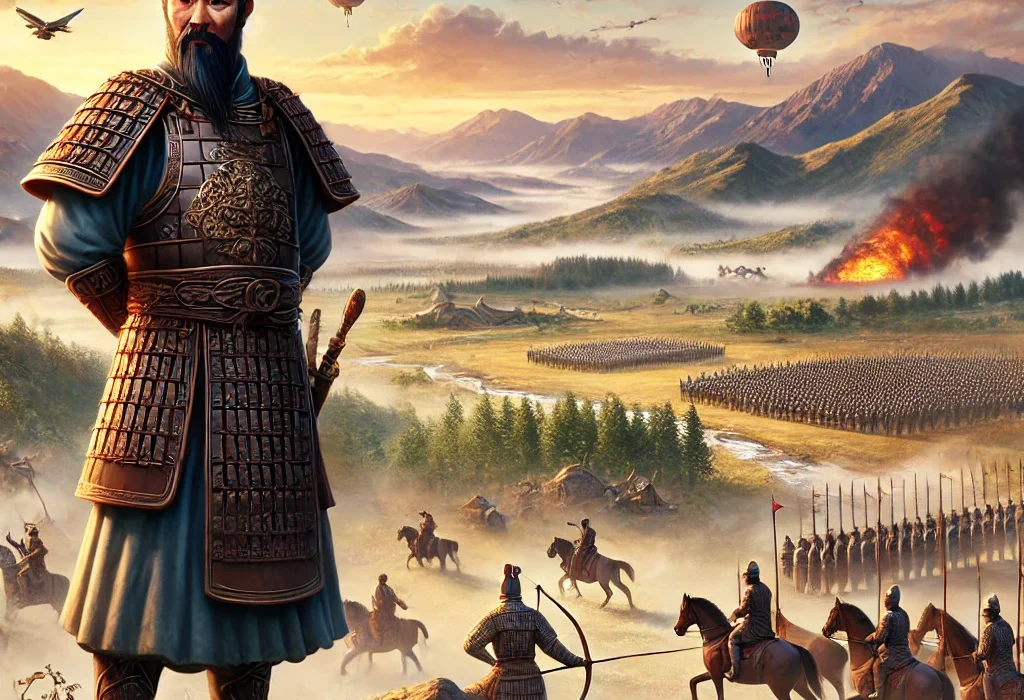“The Art of War,” attributed to Sun Tzu, is an ancient Chinese military treatise written around the 5th century BC. It is a profound text on military strategy and tactics that has been studied for over two millennia. The version you provided is translated by Lionel Giles, first published in 1910. It offers insights not only into warfare but also into management, leadership, and strategic thinking, making it a timeless guide for both military and civilian leadership.
Plot Summary
In ancient China, during a time of constant warfare among the kingdoms, a master of military strategy named Sun Tzu rose to prominence. His wisdom was sought by kings and rulers who wished to conquer their enemies with the least amount of bloodshed. It was a time when strength was not only measured by the size of an army but by the mind that commanded it. Sun Tzu, the philosopher-general, understood that the art of war lay not in brute force but in cleverness and careful planning.
Sun Tzu was summoned by the King of Wu, Ho Lu, who had heard of his reputation as a brilliant strategist. To test his theories, the king challenged Sun Tzu to train a group of concubines as soldiers. Without hesitation, Sun Tzu accepted. He divided the women into two groups, placing one of the king’s favorite concubines at the head of each. He explained the commands and what each meant, making sure they understood the difference between left and right, front and back. When he gave the first command, the women laughed, unsure whether to take the exercise seriously. Sun Tzu repeated the instructions, sternly reminding them that if the orders were clear but not followed, it was the fault of the leaders.
He gave the command again, but the women laughed once more. At this, Sun Tzu called for the execution of the two lead concubines, explaining that if the soldiers disobey, it is the leader’s failure, and punishment must follow. The king, horrified that his favorite concubines were about to be killed, protested, asking Sun Tzu to spare them. But Sun Tzu replied that once he had been entrusted with command, he could not be influenced by personal favoritism. The concubines were executed, and their replacements swiftly obeyed every order. With precision, they followed every command Sun Tzu issued. The lesson was clear: discipline and obedience were the foundation of a successful army.
Having proven his capability, Sun Tzu was appointed as the general of the army of Wu. Under his leadership, the army achieved victory after victory. Sun Tzu’s brilliance lay not just in the battles themselves but in the unseen moves that led up to them. He believed that the greatest victories were won without ever needing to engage in battle. It was better to outmaneuver the enemy, breaking their will without bloodshed, than to destroy them outright. His strategies emphasized deception, suggesting that an army should appear weak when strong, far when near, and disorderly when most prepared.
Sun Tzu understood that war was not merely a clash of swords but a contest of minds. Victory came to those who could foresee the enemy’s plans and adapt their own accordingly. In his campaigns, Sun Tzu led the army of Wu against formidable opponents. The powerful state of Chu fell before his strategic brilliance. Sun Tzu conquered Ying, its capital, striking fear into the hearts of neighboring states. The other kingdoms began to whisper his name, and his reputation as an invincible general spread far and wide.
Central to Sun Tzu’s approach was the belief that warfare should be swift and decisive. A prolonged war drained resources, weakened the army’s morale, and left a state vulnerable to other threats. The army that remains too long in the field will see its weapons grow dull, its energy fade, and its coffers empty. Thus, Sun Tzu instructed his soldiers to move like the wind, quick and unrelenting, and to strike where the enemy was least prepared. In battle, surprise was the greatest weapon, and victory often came from attacking the enemy’s weak points.
He taught that a general must adapt to the shifting circumstances of the battlefield. Just as water shapes itself to the ground, flowing around obstacles and filling gaps, so must a general shape his strategy according to the enemy’s movements and the terrain. If the enemy was well prepared, it was better to avoid direct confrontation. If the enemy was arrogant or disorganized, it was time to strike with full force. Above all, the general must keep his own plans hidden from the enemy, only revealing his strength at the moment of decisive victory.
Sun Tzu also placed great emphasis on the role of intelligence in warfare. A general must know his enemy as well as he knows himself. Spies were essential to his strategy, for it was through their reports that Sun Tzu gained insight into the enemy’s plans, weaknesses, and strengths. He employed local informants, enemy defectors, and even the enemy’s own spies, turning them into double agents. With their help, Sun Tzu could shape the battlefield to his advantage before the enemy even realized the true nature of the conflict.
Sun Tzu’s wisdom extended beyond the battlefield. He advised rulers on the importance of moral authority, showing how a ruler who gained the loyalty and trust of his people could inspire them to follow him into any danger. A good general was not merely a commander but a caretaker of his soldiers, treating them with both strict discipline and deep compassion. Soldiers who felt cared for would fight with greater ferocity, willing to lay down their lives for the general who had earned their loyalty.
In the end, Sun Tzu’s lessons were not just about war, but about the nature of conflict itself. Whether on the battlefield or in the halls of power, victory went to those who could see beyond the immediate and who could understand the larger forces at play. Sun Tzu’s strategies echoed through the ages, teaching that war, like life, was a delicate balance of strength and wisdom, force and deception, loyalty and strategy. In every situation, success came to those who could master these forces and bend them to their will.
Main Characters
While “The Art of War” is not a narrative work with traditional characters, Sun Tzu himself emerges as the key figure in the text. He is often considered a legendary figure, though historical records indicate he was a military strategist who served the state of Wu during the Eastern Zhou period.
- Sun Tzu (Master Sun): The author and philosopher of the treatise, he is depicted as a wise and pragmatic strategist. His central focus is on winning wars with the least amount of conflict possible, emphasizing intelligence, preparation, and adaptability.
Other “characters” could be seen as archetypes—such as the General or Ruler—whose roles Sun Tzu advises on how to lead, discipline, and maintain control over their armies or state.
Theme
Strategic Warfare: A central theme of the book is the concept of warfare as an art form. It is not about brute force but about the application of strategy, deception, and psychological manipulation to outmaneuver the enemy.
Deception and Intelligence: Sun Tzu consistently emphasizes the importance of misleading the enemy to gain an advantage. Warfare, in his view, is largely about the management of perception, both of oneself and the opponent.
Adaptability and Flexibility: The ability to adapt to changing conditions is crucial. Sun Tzu advises against rigid adherence to plans and instead advocates for flexibility in response to the ever-changing dynamics of the battlefield.
Economy of Resources: Sun Tzu believes in minimizing resource expenditure, including human lives and material. He argues for swift and efficient actions that lead to quick victories rather than prolonged engagements that drain resources and morale.
Moral Law and Leadership: Leadership plays a pivotal role in the success of military campaigns. Sun Tzu outlines the importance of a general’s wisdom, integrity, and ability to enforce discipline while maintaining the loyalty of their troops.
Writing Style and Tone
The writing style of “The Art of War” is terse, yet deeply profound. Sun Tzu’s instructions are conveyed through succinct, aphoristic statements that are open to interpretation across various situations. The language is simple, yet the ideas are complex, often requiring readers to reflect on how to apply the principles in diverse contexts.
The tone is authoritative and instructional, imbued with the wisdom of a sage advising his audience on life-or-death matters. It is direct yet philosophical, encouraging contemplation. The text also carries a detached tone, reflecting the cold pragmatism required of military strategy, where human emotion must not interfere with achieving victory.
We hope this summary has sparked your interest and would appreciate you following Celsius 233 on social media:
There’s a treasure trove of other fascinating book summaries waiting for you. Check out our collection of stories that inspire, thrill, and provoke thought, just like this one by checking out the Book Shelf or the Library
Remember, while our summaries capture the essence, they can never replace the full experience of reading the book. If this summary intrigued you, consider diving into the complete story – buy the book and immerse yourself in the author’s original work.
If you want to request a book summary, click here.
When Saurabh is not working/watching football/reading books/traveling, you can reach him via Twitter/X, LinkedIn, or Threads
Restart reading!








